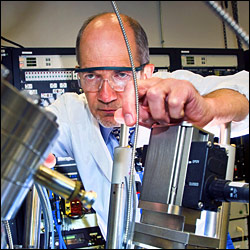A Brookhaven National Laboratory team led by Ivan Bozovic at the U.S. Department of Energy (DOE) has used an atom-by-atom layering method to develop an ultrathin field effect device like a transistor that will help analyze conditions that convert insulating materials into superconductors at high temperatures.
The research paper has appeared in the April 28th issue of Nature. This development could help develop nonresistant electronic devices. Brookhaven physicist Ivan Bozovic, who is the main author of the paper, says the device will reveal what takes place when the insulating copper-oxide material changes to the superconducting state.
 BNL's Ivan Bozovic
BNL's Ivan Bozovic
An external electric field is applied to enhance or lower the doping level of electrons moving in the material. This will show how it influences the material to transport current. Thin films of uniform composition and electric fields measuring over 10 billion volts per meter are required to achieve this in copper-oxide (cuprate) superconductors.
The team used the molecular beam epitaxy (MBE) method to help develop the superconducting thin film layers one by one with accurate control of each layer’s thickness. Even a single cuprate layer in such films could display high-temperature superconductivity. The same method has been used to create ultrathin superconducting field effect products that help obtain the charge isolation and electric field strength.
The devices resemble field-effect transistors (FETs) where a semiconducting material carries electrical current from the electrode source on one end of the device to a drain electrode on the other. FETs are monitored by an electrode called a gate placed above the source-drain conduit, which turns the device on or off when gate voltage is applied. The positively charged ions move to the negative electrode while the negatively charged ions move to the positive electrode. The ions stop when they reach the electrodes. The electrode walls transport equal amount of opposing currents. The temperature of a model high-temperature superconductor compound could be controlled by 30° Kelvin. The electrons form pairs in the insulating state also. The devices are energy efficient. The design helps control superconductivity with an outside electric field.
Source: http://www.bnl.gov